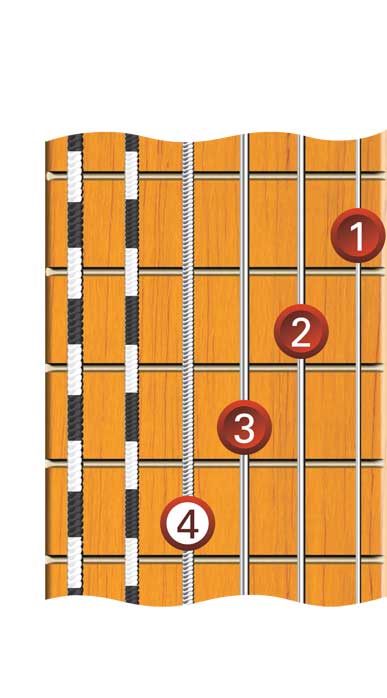
More Jazz Chords and Techniques
In this lesson you will learn how to expand upon the basic Jazz style. Several more Jazz chords are introduced as well as some more left hand and right hand techniques that can be incorporated into the Jazz fingerpicking style.
Lead-in Chords
A popular rhythm technique is the use of lead-in chords. A lead-in chord is often a chord played just before a new chord change. The chosen chord is usually the same chord, only one fret lower or higher. Lead-in chords are used in the following example.



Arpeggio Style Jazz
Another distinguishing feature of the Jazz fingerstyle guitar is the use of the arpeggio style. The arpeggio style was first introduced in Lesson 6. The following example applies the arpeggio style to an eight bar progression that features major seventh chords.


Major Sixth Chords
Major sixth Jazz chord shapes are the next set of chords to. Study the following two diagrams that highlight the root six and root six major sixth chords.

Major Sixth (root six)

Major Sixth (root five)

Major Sixth (root five)
Major sixth chords feature in the following example.

Jazz Chord-First Position
Here is a selection of Jazz chord shapes which are played mainly on the first three strings. When fingerpicking these chord shapes the right hand will be in the first position. The right hand 1st finger (i) is allocated to the 3rd string.
The 2nd finger (m) is allocated to the 2nd string and the 3rd finger (a) is allocated to the 1st string.

Major Root Four

Major Root Two

Major Root Three

Minor Root Four

Minor Root Four

Minor Root Two

Seventh Root Four

Seventh Root One

Seventh Root Three

Maj. Seventh Root Four

Maj. Seventh Root Four

Maj. Seventh Root Three

Min. Seventh Root One

Min. Seventh Root Five

Min. Seventh Root Four

Major Sixth Root Three

Major Sixth Root Four

Major Sixth Root one
The following example makes use of many of these chord shapes. This chord progression is also in ^ time, a total of three beats per bar. A combination of the bass chord style and the arpeggio style is used. Once you are familiar with the progression, experiment by playing the same chords but using a different root position. A good Jazz fingerpicker needs to know as many different chord positions as possible.






Minor Sixth Chords
Three Jazz shapes for the minor sixth chord are now shown. The first shape is a second position chord. The other two shapes first position shapes.

Minor sixth (root six)

Minor sixth (root one)

Minor sixth (root five)
Minor sixth chords feature in the following example.





Ninth Chords
The final chord to learn in this lesson is the ninth chord. The ninth chord is popular chord used in Jazz and Blues. Study the following diagrams and then try example 177 that makes use of all three chord shapes.

Ninth (root six)

Ninth (root five)

Ninth (root four)



